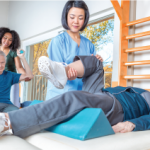“We put a pedometer on her, and it was amazing how much physical activity she was getting. But if I hadn’t asked, I wouldn’t have known,” Dr. Steinbarger says.
One issue that comes up with children with JIA is encouraging them to continue to be active in classes, such as PE—even if parents wonder if they can be excused. Occupational therapists may recommend patients’ parents work with their school to create a 504 plan, which enables schools and teachers to remove barriers from learning for students with disabilities. In the case of a child with JIA, this may include accommodations, such as a tailored plan for PE so they still have activities they can do. Because JIA is not a common condition, there is sometimes pushback from PE teachers regarding accommodations, Ms. Black says.
Exercise Through Pain?
Both Ms. Black and Dr. Steinbarger acknowledge the role pain plays in physical activity when a patient has rheumatic disease. Dr. Hausmann asked when should a patient push through pain and when should they not?
If it’s new pain, it’s crucial to attend to and try to figure out the cause, Ms. Black says. This pain differs from the soreness patients experience when they first start exercising, which can be a “good” pain.
For centralized pain, specialists in OT and PT can help address the pain with movement and other cognitive strategies. Part of that is teaching patients the difference between pain related to injured tissues and pain for which there’s no physical injury, Dr. Steinbarger notes.
Misconceptions
Dr. Steinbarger and Ms. Black shared two common questions patients with rheumatic disease have about physical activity . One of these is whether it’s OK to exercise if there’s a flare. Dr. Steinbarger says physical activity should continue, although the kind of movement may differ.
“You can’t stop moving. You’re just going to move differently. There should be a plan for that,” she says. “You can make that plan with your physical therapist or OT.”
On the pediatric side is the misconception that kids with arthritis can’t or shouldn’t do sports. Ms. Black notes that most of them can so long as they avoid contact sports, such as football or boxing. She adds that there may need to be some adaptations and allowances for rest breaks.
Vanessa Caceres is a medical writer in Bradenton, Fla.
Reference
- Onel KB, Horton DB, Lovel DJ, et al. 2021 American College of Rheumatology Guideline for the treatment of juvenile idiopathic arthritis: recommendations for nonpharmacologic therapies, medication monitoring, immunizations and imaging. Arthritis Rheum. 2022 Apr;74(4)570–585.


